On the eve of taking office, dig deeper into the changes made by the Trump administration in the crypto sector

Reprinted from panewslab
01/20/2025·3MPreface
Recently, a draft of an "Executive Order to Support Cryptocurrency" purportedly drafted by Trump's team unexpectedly leaked out, quickly causing uproar in the market. The draft proposes that in future plans to include cryptocurrencies in the U.S. strategic reserve, priority may be given to cryptocurrency projects founded in the United States and supported by U.S. institutions, such as XRP, SOL, and USDC. As soon as the news came out, both XRP and SOL experienced significant increases in the short term, triggering heated discussions in the market.
It is worth noting that shortly after the draft executive order was exposed and when Trump took office, Trump himself announced on Twitter the issuance of a token called "TRUMP" to promote "a very special Trump" Universal Community” and celebrate the “victories” of everything we stand for. The market’s interpretation of Trump’s personal decision to “issue coins” is quite enthusiastic: Some people believe that this is a signal of “deeper binding between politics and the encryption circle”, while others question whether this will trigger a wider regulatory controversy.
Looking back at Trump's "clearly stated" support for cryptocurrency many times during the election, the "Ten New Deals on Cryptocurrency" he once proposed has also become an important factor in attracting a large number of cryptocurrency fans. Since his successful election, Trump has been fulfilling his promises step by step: for example, appointing Musk as the head of the "DOGE" Department of Government Efficiency, appointing David Sachs as the White House cryptocurrency director, and appointing Paul Atkins. Serves as the new SEC Chairman. These personnel changes reflect a strong signal: the Trump 2.0 government is very likely to "fully embrace" cryptocurrency from a policy level.
So, what exactly does the “Ten New Deals on Cryptocurrency” include? How do they fit in with Trump’s new appointments? What impact will it have on the cryptocurrency ecosystem in the United States and even the world? This article will start with the current situation of the U.S. economy, analyze why Trump chose to use cryptocurrency as a "breakthrough" under the pressure of trade deficit and national debt crisis, and explore the investment opportunities hidden in this wave of cryptocurrency globalization, providing a basis for Readers are provided with a more comprehensive perspective of the “Trump Cryptoeconomic Framework.”
(The following content is based on current public information, speculation and analysis of the development of U.S. politics and cryptocurrency around 2025, and is not a fait accompli.)
1. Trade deficit + national debt crisis
1.1 Starting from the “Reagan Cycle”
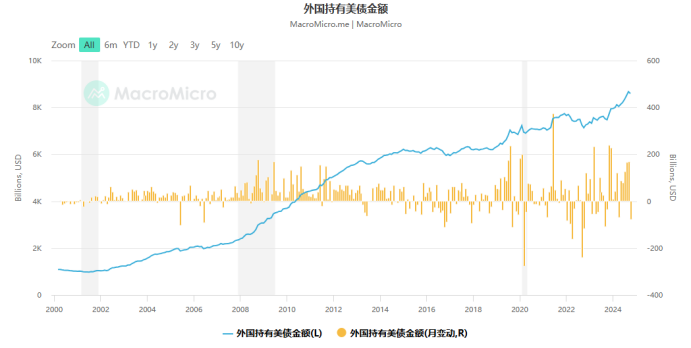
Source:MacroMicro.com
To understand the preference for cryptocurrencies in the Trump 2.0 era, we must first review the long-standing “old problems” in the U.S. economic structure—the trade deficit and national debt crisis.
After World War II, the United States relied on its advantages and strength as a victorious country to import a large amount of U.S. dollars (then gold-linked Bretton Woods system) into European countries through the "Marshall Plan" to assist the reconstruction of these war-torn economies. Strengthened the relationship between the United States and its allies. However, as Europe gradually recovers, countries are no longer willing to accept the fixed exchange rate system, and have exchanged their U.S. dollars for gold, which is more valuable, resulting in the continuous loss of U.S. gold reserves. Finally, in the 1970s, the dollar was completely decoupled from gold.
In the Reagan era (1980s), in order to consolidate the hegemony of the U.S. dollar, the United States adopted policies of "significant tax cuts, increased defense spending, and high interest rates" to build a global U.S. dollar circulation system, often called the "Reagan Cycle." :
1. High interest rates attract global capital to flow into the United States, and investors buy U.S. Treasury bonds and other U.S. dollar assets to obtain high returns;
2. Large capital inflows lead to an appreciation of the U.S. dollar, making U.S. imported goods cheaper;
3. Export commodity prices have risen, losing competitiveness, and the trade deficit continues to expand;
4. These trading partners will return the U.S. dollars obtained to the United States through the purchase of U.S. bonds to support the U.S. fiscal deficit and consumption.
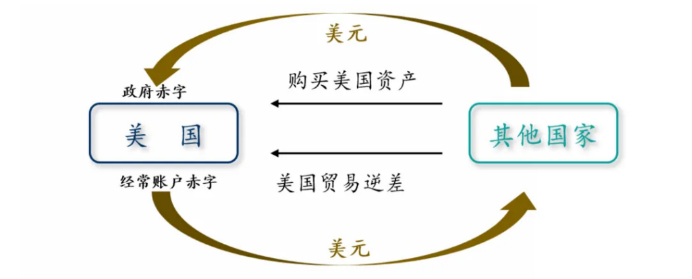
Source:HUATAI SECURITIES RESEARCH
This cycle has established the strong position of the U.S. dollar in the world, but it has also laid the foundation for the ever-expanding trade deficit and hidden dangers of U.S. debt.
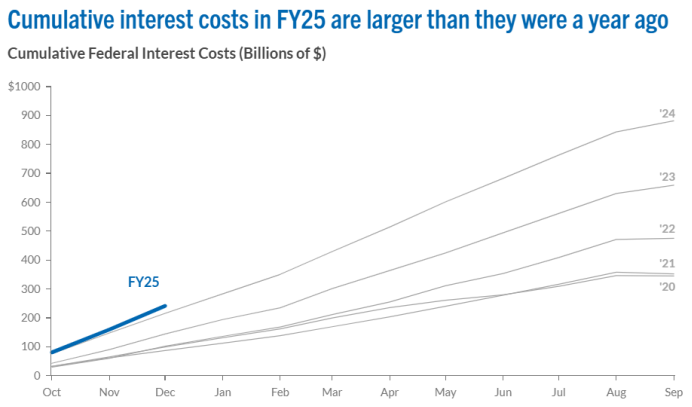
Source:Department of the Treasury
This cycle has continued for nearly 50 years, with the rapid accumulation of federal debt, coupled with rising debt interest rates (relative to the past decade or so), pushing up the federal government's borrowing costs. In fact, as of December 2024, Treasury interest payments are higher than in previous years. Interest costs are already the federal government's third-largest expense category, surpassing spending on Medicare, income security, Medicaid and veterans' benefits and services.
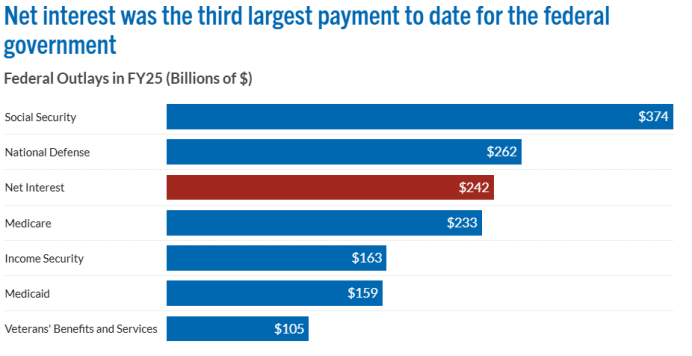
Source:Department of the Treasury
1.2 China: the largest source of U.S. trade deficit
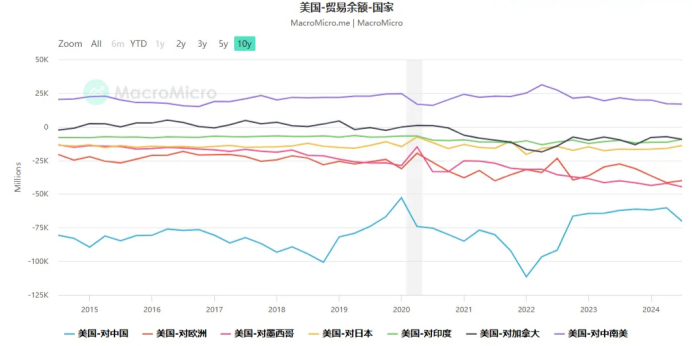
Source:MacroMicro.com
According to statistics from the U.S. Department of Commerce over the years, the U.S.’s largest trade deficit currently comes from China, and China has therefore become one of the U.S.’s largest creditor countries. After 2018, Trump launched a trade war against China, hoping to reduce the deficit by raising tariffs, but overall the United States still maintains a fairly high trade deficit. For the Trump administration in 2025, how to reduce the trade deficit remains a major issue.
1.3 Trump’s “two axes” and “ finding another way ”
The Trump administration has two main ideas for reducing the trade deficit:
1. Spending reduction: increase tariffs and reduce imports
2. Open source: improve exports
However, after a tariff war is implemented, other countries will also impose higher tariffs on U.S. products, which may be counterproductive. To this end, Trump 2.0 will still adopt stimulus measures such as "reducing corporate taxes" to attract manufacturing and service industries back to the United States. But corporate tax breaks alone are not enough. A new set of tools is needed to ensure that production returned to the United States can be exported smoothly.
This time, Trump chose cryptocurrencies.
2. “Ten New Deals for Cryptocurrency”: From Cutting to Building
From Trump 2.0’s economic policies, it is not difficult to see that he follows the “Reagan model”: using some kind of dollar substitute or dollar external circulation tool to consolidate the United States’ global financial position. The difference is that the Reagan era mainly relied on U.S. debt, while Trump tried to create a new world economic cycle by vigorously promoting cryptocurrency.
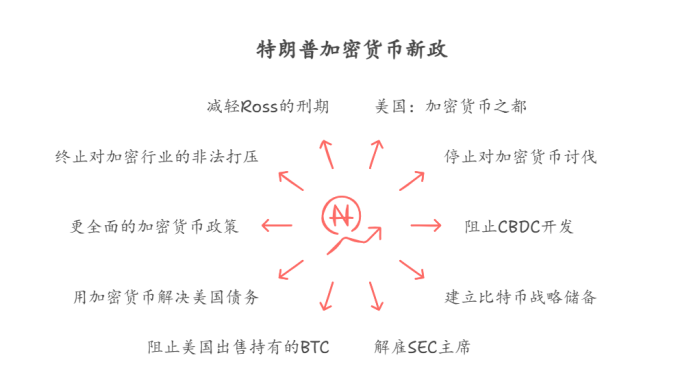
Looking back at the "Ten New Deals for Cryptocurrency", it can be summarized into three main lines of "cutting, development and construction":
2.1 Cutting
1. Stop the crusade against cryptocurrency
Within one hour of taking office, Trump immediately fired former SEC Chairman Gary Gensler and appointed more relaxed regulators to end frequent enforcement actions against cryptocurrency companies and make the regulatory environment more friendly to blockchain companies.
2. End the United States’ illegal suppression of the encryption industry
Ending the United States’ illegal crackdown on the crypto industry means that Trump may repeal SAB 121 cryptocurrency accounting principles after taking office. SAB 121 is an accounting announcement issued by the U.S. Securities and Exchange Commission (SEC) in 2022, requiring institutions that custody crypto assets to record them as liabilities and record corresponding assets. In actual implementation, this is almost equivalent to "banning banks from hosting cryptocurrencies" because it is difficult for the banking system to value and disclose according to this rule.
If SAB 121 is repealed, traditional financial institutions in the United States can legitimately provide cryptocurrency custody services, providing users with a more convenient custody solution than hardware wallets and multi-signature wallets, which also means that the barriers between traditional finance and cryptocurrency will be broken down.
3. Block the development of central bank digital currency (CBDC)
Trump has repeatedly stated that he will not allow the government to issue CBDC, believing that it will give the government too much financial control and infringe on personal privacy. On the contrary, he emphasized the need to safeguard the public's right to keep digital assets by themselves and adhere to the principles of "decentralization" and "freedom."
4. Reduce the sentence of Silk Road founder Ross Ulbricht
Trump’s possible “pardon” or substantial commutation of Ross Ulbricht’s sentence would be both a political gesture and a symbol of a reaffirmation of cryptocurrency’s original “liberal” values. At the regulatory level, it may also provide more legal space for private use of cryptocurrencies.
2.2 Development
1. Establish a Bitcoin strategic reserve
The Trump administration is inclined to convert the Bitcoin currently held by the United States (including the portion confiscated by law enforcement agencies) into a national strategic reserve to further implement the "BTC digital gold" status. In the past decade, Bitcoin has been increasingly regarded by institutions and investors as an anti-inflation and anti-risk asset. If a world power like the United States formally incorporates BTC into its reserves, both allies and competitors may rush to follow suit.
2. Prevent governments from selling Bitcoin
Echoing the "establishment of strategic reserves," Trump hopes to prevent the U.S. government from selling its Bitcoin holdings on the market to stabilize the "official recognition" of BTC. This will undoubtedly become an important factor in pushing up the price of Bitcoin.
3. Use cryptocurrencies to deal with debt issues
The U.S. government may incorporate confiscated Bitcoin or other crypto-assets into fiscal instruments to pay part of the interest on national debt and reduce the pressure on government debt. In 2024, federal government debt interest payments will exceed US$880 billion (accounting for 3.1% of GDP). If digital assets such as Bitcoin can participate in fiscal operations, it means that cryptocurrencies have the opportunity to enter the category of national fiscal tools.
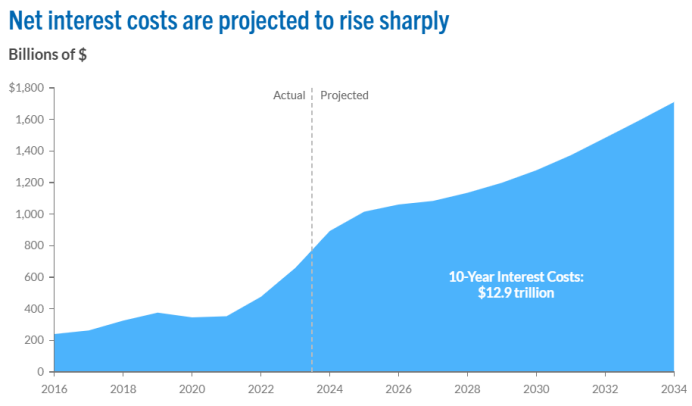
Sources:Congressional Budget OfficeandOffice of Management and Budget
3.3 Build
1. Make the United States a Bitcoin mining powerhouse
Attract mining companies to settle in the United States through reduced energy costs, tax breaks, etc., in order to control a higher proportion of global BTC computing power.
2. Promote the "21st Century Financial Innovation and Technology Act"
The bill may clarify the regulatory boundaries of the SEC and CFTC on cryptocurrencies and strengthen information disclosure requirements. If Trump prefers to place most cryptocurrencies under the jurisdiction of the CFTC, it will mean that more tokens will be recognized as "commodities" rather than "securities." Thus, it creates convenience for local American companies to issue coins overseas. Once the tokens are purchased by overseas users, it is equivalent to the United States gaining "export revenue" and helping to reduce the trade deficit.
3. Accelerate the construction of stable currency system
The Trump administration plans to allow compliant stablecoin issuers to directly access the Federal Reserve payment system to achieve faster settlement and lower costs, further expanding the U.S. dollar’s global trading advantages.
3. On the eve of taking office: Trump tweets about currency
On January 17, 2025, Trump announced the launch of a cryptocurrency called $TRUMP on his social media platform. The price of the token soared more than 240 times in just 24 hours, and the full circulation market value soared from zero to $45 billion. Trump holds 80% of the token supply through his company CIC Digital LLC, which means that his personal net worth may increase by tens of billions of dollars. As we mentioned before, the United States is facing the challenges of trade deficit and U.S. debt crisis, so the United States needs to "make money for itself." Trump’s issuance of coins has given Wall Street institutions a reference and also given global financing institutions a reference. High-efficiency financing on the web3 chain has officially challenged the traditional financing methods of web2. Combined with the characteristics of the Trump 2.0 government, $TRUMP in the future may be used as a easing agent for government fiscal planning or U.S. debt interest costs.
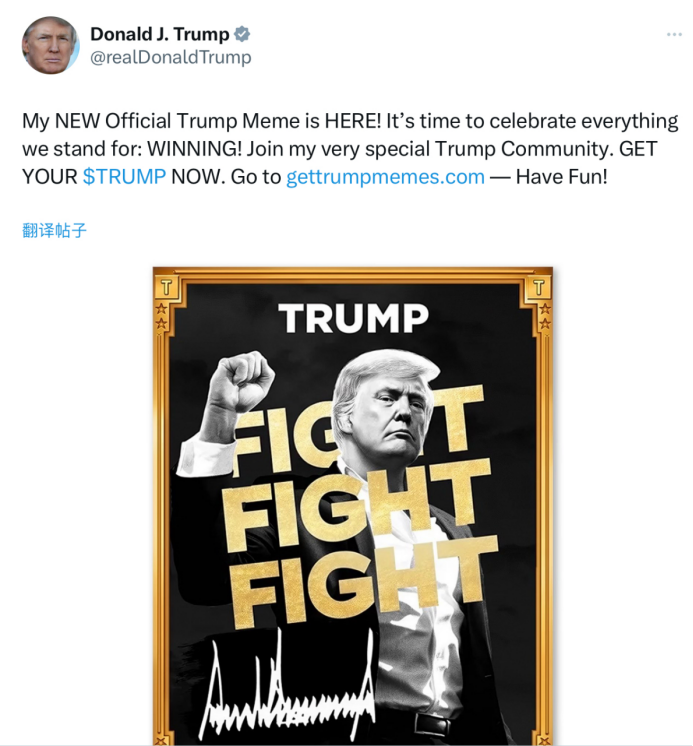
Sources:X
4. From Twitter to the White House **: Building dual engines of
cryptocurrency and technology**
In addition to the "Ten New Deals", Trump's personnel layout also releases a lot of signals:
4.1 Establish DOGE (Government Efficiency Department)
On November 12, 2024, Trump announced the formation of the "Department of Government Efficiency" (DOGE), which will be jointly run by the technology giant Musk and the young politician Vivek Ramaswamy, aiming to reduce government bureaucracy and streamline supervision. , Cut down on wasteful spending. Musk’s own love for DOGE is well known, which has fueled market speculation that “Dogecoin may receive special support.”
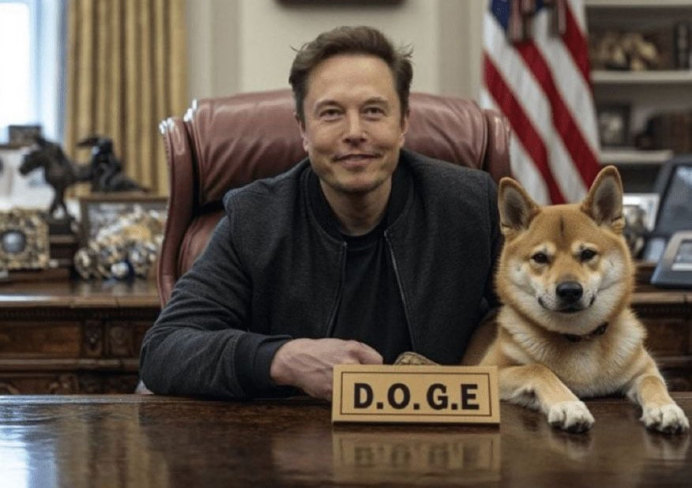
**4.2 Appointment of David Sacks as White House Chief of Artificial
Intelligence and Cryptocurrency Affairs**
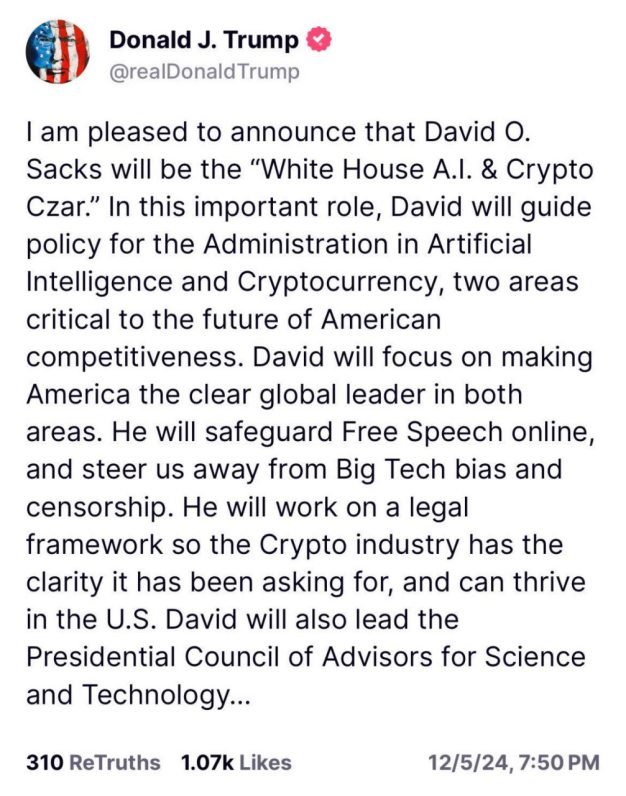
Sources:X
On December 5, 2024, Trump announced a blockbuster appointment on social media: David Sachs, former chief operating officer of PayPal, will be responsible for the White House’s AI and cryptocurrency affairs. Sacks is a long-term supporter of Solana, has also invested in crypto fund Multicoin Capital, and had a close relationship with Musk during the PayPal era. This move indicates that opportunities to integrate blockchain and AI industry chains will receive much attention.
4.3 Paul Atkins becomes SEC Chairman
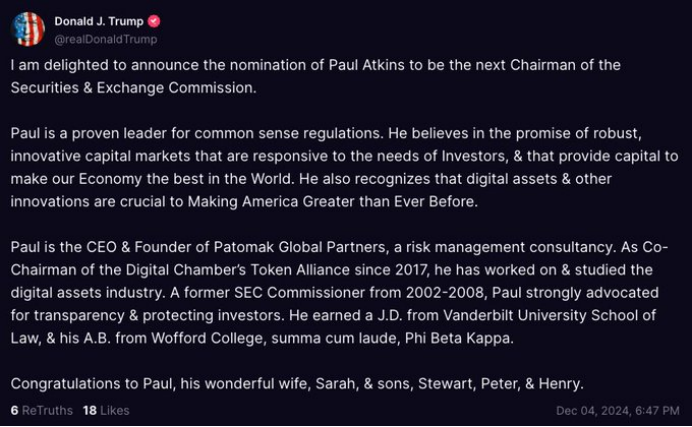
Sources:X
On December 5, 2024, Trump officially nominated Paul Atkins, a former SEC member, to serve as SEC Chairman. Atkins has a relatively open attitude towards digital assets and has always called for maintaining market transparency and protecting investors. The arrival of the new SEC chairman will undoubtedly further promote the compliance and institutional development of cryptocurrency.
**5. The combination of technology and cryptocurrency: driving U.S.
exports**
From these new appointments, we can see that Trump 2.0 attaches great importance to the integration of "blockchain + AI", which is actually directly related to the macro goal of "open source" to increase exports.
At this stage, AI companies represented by OpenAI generally suffer from high investment costs and unclear profit models. OpenAI's annual revenue in 2024 will be US$4 billion, but in summary, it will lose US$5 billion. The main source of income is the monthly subscription fees of paying users of ChatGPT. Although ChatGPT’s paid subscription revenue is of a certain scale, it is far from enough to cover the huge R&D and cloud computing costs.
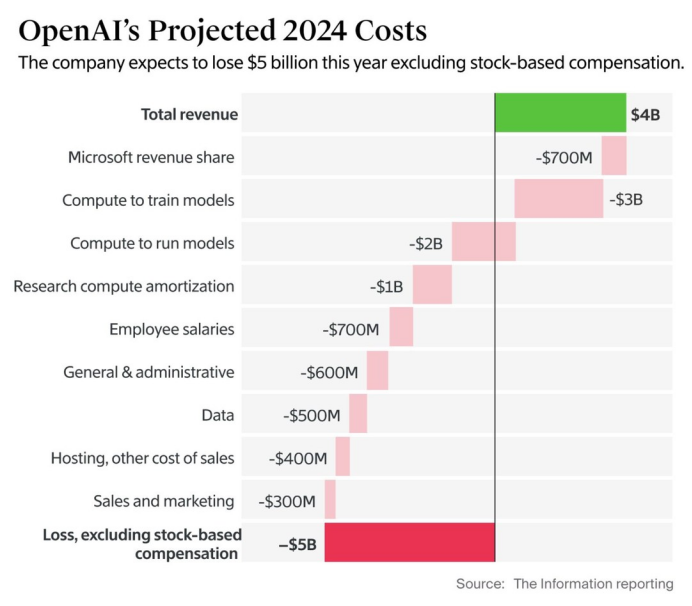
If cryptocurrency is introduced into its business model, for example:
1. Assuming that OpenAI issues its own token, users need to purchase this token to call AI services such as ChatGPT;
2. In order to use these services, global users need to exchange tokens with US dollars or other legal currencies for payment;
Once this model is implemented on a large scale, every token buyer from around the world will be equivalent to exporting services to the United States and paying "foreign exchange", thus bypassing many tariffs and regulatory barriers and helping the United States form new digital product exports.
**6. Unrestricted global trading of crypto assets: an alternative
breakthrough under de-globalization**
At a time when anti-globalization trends are on the rise, many countries (such as China, India, etc.) have strict foreign exchange controls, which has brought considerable obstacles to traditional foreign trade. The characteristic of cryptocurrency is that it can circulate freely across borders and does not need to be restricted by the traditional SWIFT system or bank controls. This natural advantage of "decentralized finance" has opened up new global transaction channels for the Trump 2.0 government. With sufficient policy support, the United States’ first-mover advantage in the cryptocurrency field may be further expanded.
7. Investment opportunities and risk warnings
7.1 Investment opportunities
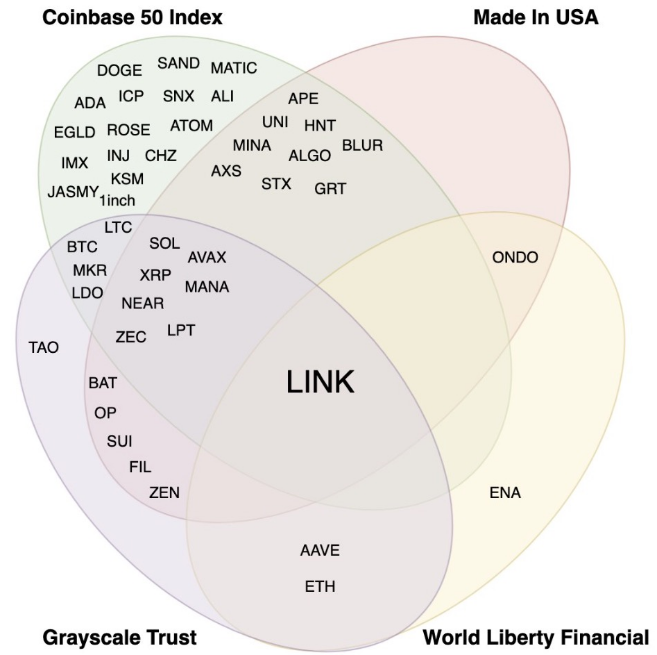
1. Prioritize projects led by American teams or companies
The Trump administration is obviously inclined to support "Made in America" blockchain projects, such as XRP, SOL, USDC, etc. If relevant projects can reach cooperation with the White House, consortiums, and financial institutions, they may gain convenience in supervision, compliance, bank custody, etc.
2. Pay attention to the tokens included in Trump’s “white list” (such as WLFI, etc.)
The DeFi project World Liberty Financial (WLFI) supported by the Trump family and its token list are also potential tracks. However, it should be noted that such projects often involve the risk of "policy bias". If the political wind direction changes, the project may also face compliance risks.
3. Focus on endorsements from large compliance agencies
In the more friendly regulatory environment in the United States, traditional financial giants or compliance platforms such as Coinbase, Grayscale, and BlackRock are still important benchmarks. Crypto projects that receive their support are generally more robust.
4. Don’t ignore MEME culture
Both Trump and Musk strongly advocate "community liberalism" on social media, which coincides with the spirit of MEME coins such as Dogecoin (DOGE). As the leader of MEME coins, DOGE has the possibility of rising sharply in any policy or social media hot event.
7.2 Risk warning
Regulatory changes: Although Trump is in charge, there are still games between different interest groups in the U.S. Congress, Treasury, Federal Reserve, and judicial departments, and policy advancement is not smooth sailing.
Market Volatility: The cryptocurrency market has historically been highly volatile, and any sudden event (a black swan or macro policy change) can cause prices to plummet.
8. Conclusion
Under the dual pressure of national debt and trade deficit, the United States urgently needs to expand its export-oriented income. The cryptocurrency “overtaking” strategy chosen by Trump 2.0 is not only a new attempt to integrate finance and technology, but also may become its key in the international financial game. Another sharp weapon.
However, any grand plan faces practical constraints: the internal political struggle in the United States and the vested interests of traditional financial institutions, the international community's vigilance against the "domestic dominance" of the United States, and the high risks and regulatory difficulties of the crypto market itself, all contribute to this. The “encryption revolution” has added huge uncertainty. No matter what the final direction is, the most important thing is that in this policy reshaping and technological change, stay rational and actively follow regulatory and information changes, so that you can make smarter investments in a situation where opportunities and risks are intertwined. decision making.
Disclaimer: Readers are requested to strictly abide by local laws and regulations. This article does not represent any investment advice.


 chaincatcher
chaincatcher